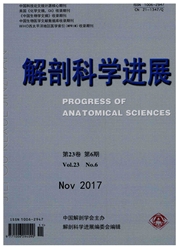

 中文摘要:
中文摘要:
目的探讨缓激肽持续作用引起的胶质瘤细胞内钙离子浓度变化([Ca^2+]i)及机制。方法培养大鼠C6胶质瘤细胞,采用[Ca^2+]i测定和免疫荧光细胞化学鉴定的方法,观察持续给予缓激肽后胶质瘤细胞内[Ca^2+]i的变化和缓激肽B2受体在细胞内的分布。结果在第一次给予缓激肽时,引起[Ca^2+]i的峰值最大,随着给予缓激肽次数的增加,缓激肽诱导的[Ca^2+]i荧光强度峰值逐渐下降,在第5次加入缓激肽时,[Ca^2+]i荧光强度峰值已无显著变化。在此过程中,缓激肽B1受体发生内化,并与胞浆中的质膜微囊蛋白caveolin-1结合。结论持续给予缓激肽可引起胶质瘤细胞内[Ca^2+]i浓度规律变化,caveolin-1可能参与此过程。
 英文摘要:
英文摘要:
Objective To study the [Ca^2+]i change and mechanism induced by continuous stimulation of bradykinin in glioma cells. Methods [Ca^2+]i assay and immunofluorescence staining were used to observe the [Ca^2+]i change and the location of bradykinin B2 receptors after the continuous treatment with bradykinin in cultured rat C6 glioma cells. Results With the first stimulation of bradykinin, [Ca^2+]i fluorescence intensity ascends to peak and descends gradually as the continuous stimulation of bradykinin, and with no significant change of [Ca^2+]i fluorescence intensity at the fifth stimulation. During this process, combination of bradykinin B2 receptors with caveolin-1 was observed in cytoplasma. Conclusions Continuous administration of bradykinin can cause the regular change of [Ca^2+]i concentration in glioma, in which caveolin-1 may be involved.
 同期刊论文项目
同期刊论文项目
 同项目期刊论文
同项目期刊论文
 Bradykinin-induced blood-brain tumor barrier permeability increase is mediated by adenosine 5'-triph
Bradykinin-induced blood-brain tumor barrier permeability increase is mediated by adenosine 5'-triph Bradykinin increases blood-tumor barrier permeability by down-regulating the expression levels of ZO
Bradykinin increases blood-tumor barrier permeability by down-regulating the expression levels of ZO Platelet-derived growth factor BB induces the migration of bone marrow derived mesenchymal stem cell
Platelet-derived growth factor BB induces the migration of bone marrow derived mesenchymal stem cell Dexamethasone enhances adenosine 5'-triphosphate -sensitive potassium channel expression in the bloo
Dexamethasone enhances adenosine 5'-triphosphate -sensitive potassium channel expression in the bloo 期刊信息
期刊信息
